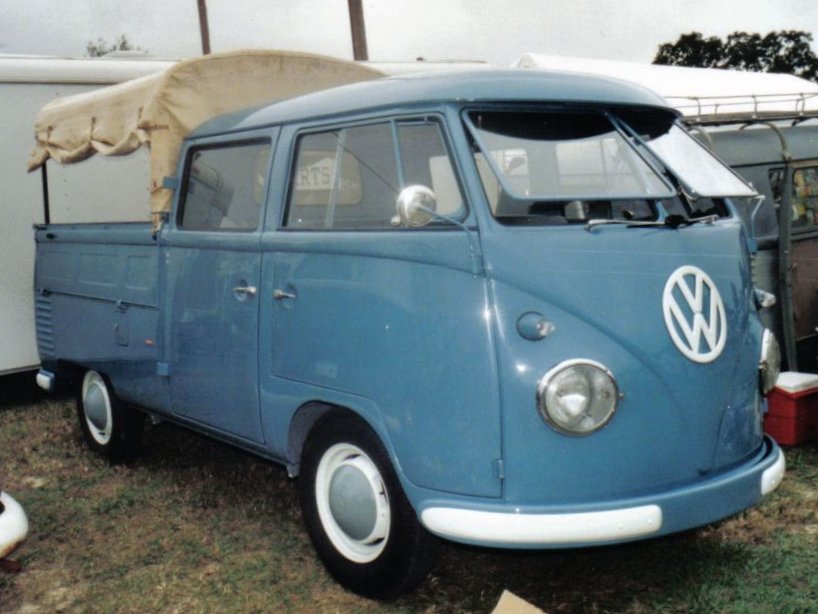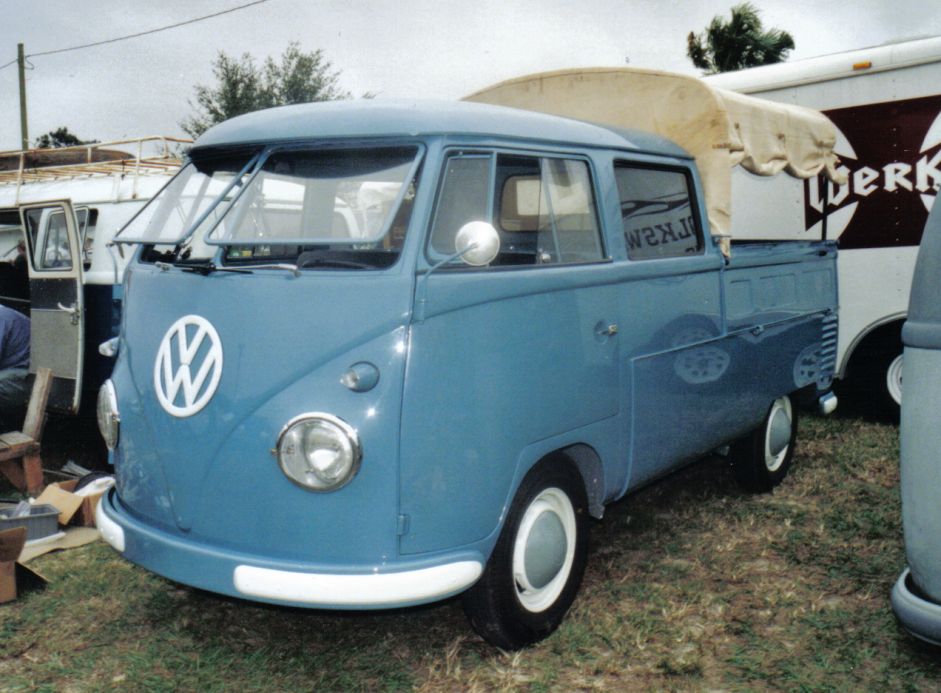 |
 |
| Binz Factory- Old and new | Binz scooter |
Have any Binz info?
The following information is accurate to the best of my knowledge and other Binz enthusiasts
working together. If you have anything to add, corrections, or just want
to talk Binz, drop me a line - Email

| Binz | Volkswagen |
 |
 |
 |
 |
Updated
2009
Wade Lloyd (webmaster)
Binz 181
History and rumors:
Magazines have reported that in the mid 50’s a nursery
worker went to the coachbuilder Binz asking for a vehicle that he could carry
plants, workers, or materials in. He also needed to have an area that was safe
from the elements. Binz answer was the modified Single cab. However there is no
information to verify the nursery worker scenario. The only information
documented for a fact is
that Binz was contracted by VW to coachbuild these vehicles as of 10/53
according to an early Volkswagen Special
options brochure.
Production figures:
Does a “Barndoor Binz” still exist or did it ever exist? Some people think that you could take a single cab you bought from VW and drive it to Binz and have them convert it. If that were true, then in theory, you could take a 53 single cab down to Binz in 1959, and have them convert it. There is only one photo known to exist of pre-55 Binz, which was obtained from the Binz factory as seen here. Whether that Binz was built in 54 or if it was taken to Binz in 58 or 59 and converted, is unknown. The earliest examples known of still in existence are 1958 models (the 27th Binz built is a 58). It is not known if any pre-58 models were ever produced for the public.
The Binz double Cab was available until February of 1959 As SO-16 or A-16 through any Volkswagen dealer, almost a year after VW had began producing their own double cab. There are rumors of 1960 Binz’s, but it has not been verified. The way the tag numbers read per month compared with trucks made and average Binz’s produced per month, it looks like production ended in 59, at an approx 550 models made, which contradicts earlier reports of “600 to 900” published elsewhere. This 550 figure does not account for any “customer walk-in’s” if that did indeed exist, which may be the extra 300 or so tacked on to that number in estimates.
Modifications:
Cab mod's- Single
cab's were
sent to Binz by the factory in primer (M-code
078), and with belly pans (M-code 191).
Binz then cut the very back of the cab off, extended the roof and then
leaded it together using an overlap seam
and lead. (notice the Binz sheet metal forward of the seam is rusting, but the
original VW cab back half hasn't, our first testament to Binz's low quality
primer/paint/preparation) Now you have a cab that is approx 85cm longer and this gave you a storage area in the back.
They then made a custom side door to access the area (early models had a suicide
door, then in 59 they changed to the normal opening
style). Binz took normal bus
upper door hinges and with some slight mod's, used them for the rear door hinges. Special larger size
glass was ordered from Sekurit for the door, as well as special profile rubber,
source unknown. A custom bulkhead was made in between the front seat and back
area, to which a Tag
was attached reading “Binz Karosserie” followed by 3653- then the production
number. The meaning of 3653 is unknown and has appeared on all Binz tags located
so far. Most likely it specified the conversion designation, since they did
many other coachbuild's.
The door- The suicide door (or normal opening in 59) is very heavy! The hinges were modeled after the front upper door hinges with a few bends in them and a different bolting pattern. Small pieces of sheet metal were formed into a hinge cover, with a single sheet metal screw running thru to hide the hinge holes once the hinges were installed. A special chrome grab handle was mounted to the inside, and the door panel has a pressed detent and a door panel made of the same material as the front door panels, was mounted. This door had a locking door handle (same as the front drivers side). A special small rubber strip went around the entire circumference of the door - except for the bottom. For the bottom, a piece of decklid seal rubber was laid horizontally across the body in the channel directly above the rocker panel.
Bed- The bed was cut out inside the new cab but they left the seam on the drivers side of the body, which is a dead giveaway for binz spotting. When the cab was moved back Binz made a special overlap seam in the bed right up next to the bulkhead - a common spot that rusted out badly over the years. Since the front part of the bed was removed, the threaded holes/inserts which hold the front hoops to the bed were lost, and it appears so far that Binz never bothered to remake them. They still flattened the 2 outer ribs to make room for the front hoop to sit. On my Binz (#181), I still have the original slat screws in place, and you can see that the outer slat on both sides run right up thru the hoops spot and to the bulkhead, so the original owner wouldn’t have been able to mount hoops without modifying the slats. Since most SC’s came with wood slats, Binz cut the slats off flush at the back of the cab and butted them against the back bulkhead. The ends of the slats at the back of the bed still retained the tapered and staggered look. The side gates were cut due to the shorter bed and a portion of the front part was removed. Binz then welded them back together and left a nasty weld bead running down the inside of the gates. Why this poor craftsmanship was tolerated, has yet to be understood. If you refer to the letters between VW and Hebmuller, you will see that VW was very upset at what they thought was a poor quality coachbuild being made by Hebmuller, all the way down to not liking the way the rubber fit or the "VW symbol being very untidy" Yet they let Binz skate by with everything under the sun. Take this for example: Binz hand formed the body panel that went in between the dogleg and rear door so they made cuts in order to ease tension to make the compound curve but didn't bother cleaning it up. Here is an example of their craftsmanship. Or check out this transition from custom bulkhead to door post. Typical Binz craftsmanship at the time. This of course has changed greatly since then with the current models.
Seat- If all these modifications weren’t enough, you could also buy a custom rear removable seat from Binz. The cost was 250DM (same price as the paint job...). It was of the tube type construction, similar to a normal bus middle seat. The seat backs were made of a coil spring construction, just like your average VW seat except for a few things- The seat frames were fastened to a piece of thick plywood and then the black stitched upholstery was wrapped around to the backside and hammered to the wood with some tack nails. Then it was finished off with an immense amounts of gun staples to the backside of the plywood. Then this whole assembly was held to the seat tube frame with large countersunk sheet metal screws going thru the frame and into the wood. The seat had special Binz only wing nuts/bolts and clamps that held it to the floor. This hardware was basically a flat piece of steel bent into a cup to hold the seat leg, with a couple of gussets welded to the side of it for strength. The hold down fastener was nothing more then a very large wing nut thru which a thread rod was inserted and welded into place. This assembly then went down thru a hole in the clamp and into a threaded portion in the floor. Not all Binz’s were ordered with the seat (evident by the absence of the the threaded holes in the floor) and of those, many are missing the seat. The rear of the seat also had 2 small rubber bumpers so it could rest against the back of the wall nicely. It is possible that the entire seat assembly came from another unknown vehicle.
Paint:
Binz paint job's were of lower standard then a
typical VW paint job. That is very evident on any of
the original paint Binz’s running around (which are extremely few). Chipping, peeling, flaking, cracking, thin spots, you name
it, its there. Compare it to a VW of the same vintage, and it’s a job even a
beginner painter may be ashamed of. Since a SC was delivered in primer to
Binz, you could have them paint it when they were done with the conversion for a
price of 260 DM. However, it appears they skimped heavily on the paint. They typically
left the ashtray in place when they painted the dash as well as the radio block
off plate, the parcel tray, the rear apron, all hand and foot controls, decklid
latch, rear apron, and other things like the high beam foot switch! Lift the ashtray of an original paint Binz and you will
often see a ring of primer. Remove the rear apron and you will see primer
underneath - unless of course Binz didn't bother to paint the engine compartment
which was common. Binz painted the majority of their truck conversions
Tauben Blau /Dove blue/ Pigeon blue (depending on what country you were
from, translates to the same thing), the standard color for VW
trucks. Pictures of early Binz’s showing it painted green and other colors
with matching rim colors and etc have also been found.
Unsolved
mystery’s:
When a vehicle was ordered in primer from
VW;
-Was the front emblem painted by Binz or VW?
-What hubcaps was it shipped with if not specified on the
options list?
What was the first year Binz built for the public?
( #28 is a
58.
Was Binz in charge of drilling and installing the rubber
bumpers for all the gates? My original paint Binz never had holes drilled in the
rear gate. Did they forget?
Did seat hardware, glass, and/or quarter window rubber come
from another source/vehicle or did Binz have it all custom made for them?
Is there a Binz out there with threaded holes for the front hoop? Still looking for any Binz’s that had mcode 070 (tilt/hoops) ordered from the factory.
Are there any Binz models currently in Europe?